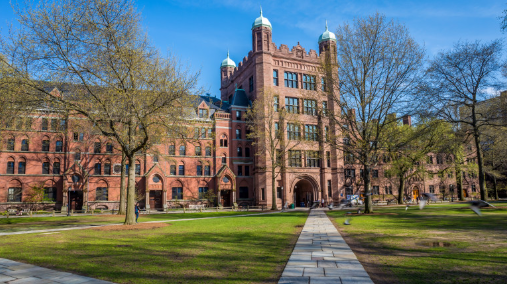Here are ten top universities in the USA that are known for offering fully funded admissions or scholarships, particularly for graduate programs, and in some cases, for undergraduate studies as well: Harvard University: Offers various fully funded scholarships through different programs, including the Harvard University Scholarships for international students. Stanford University: Provides full funding through fellowships, assistantships, and other programs, such as the Knight-Hennessy Scholars program.
Massachusetts Institute of Technology (MIT): Offers several fully funded scholarships and assistantships for graduate students and needs-based financial aid for undergraduates. University of Chicago: Provides full funding for PhD students through fellowships, assistantships, and research stipends. California Institute of Technology (Caltech): Offers full funding for most graduate students through research assistantships, fellowships, and teaching assistantships. Princeton University: Offers fully funded PhD programs and generous financial aid packages for undergraduates, which can include full tuition and living expenses.
Yale University: Provides full funding for all PhD students and generous financial aid packages for undergraduates based on need. Columbia University: Offers various fully funded opportunities through fellowships, assistantships, and scholarships, especially for graduate students. University of Pennsylvania: Provides fully funded PhD programs and needs-based financial aid for undergraduates, which can include full tuition coverage. Duke University: Offers full funding for many graduate programs through assistantships and fellowships and needs-based aid for undergraduates. These universities have robust financial aid and funding systems to ensure that deserving students, regardless of their financial background, can access top-tier education.Harvard University offers a variety of fully funded admission options, particularly for graduate students. Here are some of the key programs and funding opportunities available: Graduate Programs
Harvard Fellowships and Scholarships Harvard Graduate School of Arts and Sciences (GSAS): Offers comprehensive financial aid packages that typically cover full tuition, health insurance fees, and living expenses. Fellowships, research assistantships, and teaching assistantships are common forms of funding. Harvard Business School (HBS): Provides substantial fellowships that can cover full tuition and living expenses. The HBS Fellowship Program is one of the largest sources of support. Harvard Kennedy School (HKS): Offers numerous fellowships and scholarships, such as the Presidential Public Service Fellowship, which covers full tuition and living costs. External Scholarships and Fellowships Knight-Hennessy Scholars Program: Although based at Stanford, Harvard students are eligible to apply for this prestigious program, which provides full funding for graduate study. Fulbright Scholarships: International students can apply for Fulbright scholarships, which cover tuition, airfare, a living stipend, and health insurance for study at Harvard.
Undergraduate Programs Need-Based Financial Aid Harvard has a generous need-based financial aid policy for undergraduate students. Families earning less than $75,000 annually are typically expected to contribute nothing to the cost of education, which covers tuition, room, board, and fees. Families with higher incomes can also receive significant financial aid based on their demonstrated need. Harvard ensures that admitted students can attend regardless of financial background by meeting 100% of demonstrated financial need without requiring loans. Harvard College Financial Aid Initiative (HFAI) This initiative aims to make Harvard more accessible to students from diverse socioeconomic backgrounds by providing robust financial aid
packages. Key Points Application Process: Financial aid applications are separate from the admissions process. For undergraduates, the CSS Profile and FAFSA are required, while graduate programs have their own specific requirements. No Loans Policy: Harvard’s financial aid packages for undergraduates do not include loans, making it possible to graduate debt-free. International Students: Both undergraduate and graduate international students are eligible for financial aid and fellowships. Harvard is committed to meeting the full financial need of all admitted students. Conclusion Harvard University’s commitment to fully funding its students ensures that financial barriers do not prevent talented individuals from accessing its world-class education. Through a combination of internal and external funding sources, Harvard offers substantial support to both undergraduate and graduate students. For detailed information on specific programs and application procedures, visiting Harvard’s official financial aid website is recommended.
Stanford University offers a range of fully funded admission opportunities, particularly for graduate students, through various scholarships, fellowships, and assistantships. Here are the key programs and funding options available at Stanford: Graduate Programs Knight-Hennessy Scholars Program Description: This prestigious program selects up to 100 high-achieving students from around the world each year to receive full funding for any graduate degree at Stanford. Funding: Covers full tuition, fees, living expenses, and provides additional stipends for academic and personal development. Eligibility: Open to students across all disciplines, with an emphasis on leadership and innovation. Stanford Graduate Fellowships (SGF) Description: Competitive
fellowships that support outstanding graduate students across all disciplines. Funding: Covers tuition, a living stipend, and insurance for the duration of the student’s academic program. Research and Teaching Assistantships Description: Many graduate programs offer assistantships where students work as research or teaching assistants. Funding: Typically includes tuition remission, a stipend for living expenses, and health insurance. Departmental Fellowships and Scholarships Description: Individual departments offer various fellowships and scholarships tailored to their students. Funding: Amount and type of funding vary by department but usually cover full tuition and living expenses. Undergraduate Programs Stanford Financial Aid Need-Based Aid: Stanford meets the full demonstrated financial need of admitted undergraduate students without requiring loans. Families earning less than $150,000 annually typically pay no tuition, and those earning less than $75,000 pay neither tuition nor room and board. Merit-Based Scholarships: Stanford does not offer merit-based scholarships, focusing instead on need-based financial aid to ensure accessibility for all admitted students. Additional Funding Opportunities External Scholarships and Fellowships Fulbright
Scholarships: International students can apply for Fulbright scholarships, which cover tuition, airfare, living stipends, and health insurance for study at Stanford. Other External Funding: Various external scholarships and fellowships are available for both U.S. and international students, and Stanford’s financial aid office can assist students in identifying and applying for these opportunities. Summer Fellowships and Grants Description: Stanford offers various summer fellowships and grants for research, internships, and academic projects. Funding: Provides financial support for students to pursue educational opportunities during the summer. Key Points Application Process: For graduate programs, funding applications are typically part of the admissions process, with specific requirements varying by program. Undergraduate financial aid applications require the CSS Profile and FAFSA. No Loans Policy: For undergraduate students, Stanford’s financial aid packages are
designed to avoid student loans, ensuring that students can graduate debt-free. International Students: Both undergraduate and graduate international students are eligible for financial aid and fellowships. Stanford is committed to supporting the financial needs of its diverse student body. Conclusion Stanford University’s robust financial aid and fellowship programs ensure that financial constraints do not hinder talented students from accessing its exceptional educational opportunities. By providing comprehensive funding packages, Stanford enables students from all backgrounds to pursue their academic and professional goals. For more detailed information on specific programs and application procedures, visiting Stanford’s official financial aid and admissions websites is recommended.
Massachusetts Institute of Technology Universities in USA Offering Fully Funded Admission
The Massachusetts Institute of Technology (MIT) is renowned for its commitment to providing fully funded admission options, particularly for graduate students, through various scholarships, fellowships, and assistantships. Here’s an overview of the key funding opportunities at MIT: Graduate Programs MIT Fellowships Description: MIT offers a variety of fellowships for graduate students across different departments. Funding: These fellowships generally cover full tuition, a stipend for living expenses, and health insurance. Research Assistantships (RAs) and Teaching Assistantships (TAs) Description: Many graduate students receive funding through assistantships where they assist in research or teaching activities. Funding: These positions typically include full tuition coverage, a stipend for living expenses, and health insurance. MIT Presidential Fellowships Description: Awarded to outstanding students at the time of admission, these
fellowships are among the most prestigious at MIT. Funding: Covers full tuition, a generous living stipend, and health insurance. Departmental Fellowships and Assistantships Description: Individual departments offer various fellowships and assistantships tailored to their students. Funding: Varies by department but usually includes full tuition, a stipend, and health insurance. Undergraduate Programs MIT Scholarships and Grants Need-Based Aid: MIT meets the full demonstrated financial need of undergraduate students. Financial aid packages are need-based and do not include loans, meaning students can graduate debt-free. Funding:
Packages include grants and scholarships that cover tuition, fees, room, board, and personal expenses. MIT’s Financial Aid Initiative Description: This initiative ensures that students from low and middle-income families can attend MIT without financial burden. Funding: Families earning less than $90,000 annually typically pay nothing for tuition, and many receive additional support for other expenses. Additional Funding Opportunities External Scholarships and Fellowships Fulbright Scholarships: International students can apply for Fulbright scholarships, which cover tuition, airfare, living stipends, and health insurance for study at MIT. Other External Scholarships: Various external scholarships are available to both U.S. and international students. MIT’s financial aid office assists students in identifying and applying for these opportunities. Summer Fellowships and Grants Description: MIT offers various summer fellowships and grants for research, internships, and academic
projects. Funding: Provides financial support for students to pursue educational opportunities during the summer. Key Points Application Process: For graduate programs, funding applications are typically part of the admissions process, with specific requirements varying by program. Undergraduate financial aid applications require the CSS Profile and FAFSA. No Loans Policy: For undergraduate students, MIT’s financial aid packages are designed to avoid student loans, ensuring that students can graduate debt-free. International Students: Both undergraduate and graduate international students are eligible for financial aid and fellowships. MIT is committed to supporting the financial needs of its diverse student body. Conclusion MIT’s comprehensive financial aid and fellowship programs ensure that financial barriers do not prevent talented students from accessing its world-class education. Through a combination of internal and external funding sources, MIT provides substantial support to both undergraduate and graduate students. For detailed information on specific programs and application procedures, visiting MIT’s official financial aid and admissions websites is recommended.

